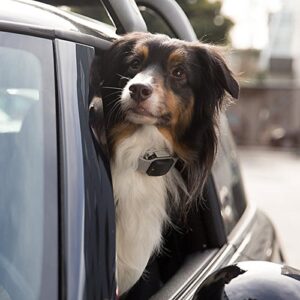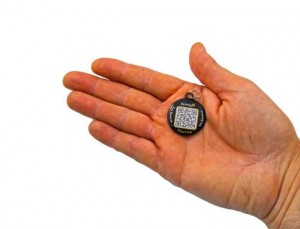
A dog owner's worst nightmare when it comes to their pet would be to have their dog get lost. Runaway dogs are an unfortunate yet common situation in many dog owners’ lives. Studies have shown that only 15-20% of dogs that run away are ever returned back to their families. When it comes to dog safety, the reasons why your dog needs a GPS tracker are numerous.
The surprisingly high number of canine runaways is most certainly linked to the fact that not enough dogs are equipped with microchips or wearing ID tags and Global Positioning System trackers. All three devices help owners find lost dogs quickly, but only GPS trackers help owners find their dogs before they become one of the 7.6 million companion animals that enter shelters every year.
RELATED: Top 5 Best Dog GPS Trackers
According to a study performed by the American Society for the Prevention of Cruelty to Animals…
“15% of lost dogs are found because they are sporting identification tags or microchips.”

That's not a very high percentage. ID tags are prone to falling off. Also, including your personal information on the collar can be a risk if you live in a big city or somewhere where you don’t know your neighbors very well.
Pet ID tags might get smudged or destroyed, either by your dog or other elements of their environment.
Dog GPS trackers are technologically advanced ways to ensure that, whenever necessary, an owner can know exactly where his or her dog is.
Dog Safety: Why Your Dog Needs a GPS Tracker
GPS trackers should not be confused with microchips. Microchips identify your dog’s location through radio frequencies. They have a short range and work by receiving a signal from a frequency reader, not unlike the ones that scan food at your local grocery store. Because they usually don’t require batteries, they can be implanted under your dog’s skin with minimal pain.
Pet GPS trackers, on the other hand, are worn on the outside. They interact with a network of space satellites that can determine the location of any object, in this case, your pet, by triangulating the signal between these satellites. GPS trackers for pets are more advantageous over microchips because they have a larger range. They reach way more extensively, which is especially helpful for large, athletic dogs that can cover a long distance if they decide to wander off.
Benefits of Dog GPS Trackers
You know that GPS trackers come in immensely handy in case your dog runs away. This is the most obvious reason to get one. You’re able to use your own personal technology to discover the exact location of your dog, and although GPS trackers are slightly expensive, they provide a safety net that pays off when you consider the alternative.
The labor and expense of launching a giant hunt for your dog, as well as the emotional strain of the search, is much greater than the $100 or so that you’ll pay for a GPS tracker upfront (some trackers also require monthly subscriptions).
When you compare the expense of a GPS tracking device to the cost of searching for your dog, the fees that shelters will charge you to get your pet back if they are found, and fines that may be given to you for having a loose dog, the tracking device may actually be the cheapest option.
RELATED: Top 5 Best Dog GPS Collars

Another great reason why your dog needs a GPS tracker is that they work in real-time. Dogs are fast, and if you’re trying to hunt down, for example, a Greyhound (this breed has been clocked at speeds of 45 mph), even a ten-second delay is too much. The dog could be long gone by then.
GPS trackers will alert you to your dog's location in real-time, without delays, so that as you’re traveling to the location, even if your dog moves, you’ll still have a good chance of getting ahead of them and not falling behind.
GPS trackers save pets’ lives in many different ways…
Millions of pets are lost yearly and those that are found are often taken to kennels and pounds. According to the same study by the American Society for the Prevention of Cruelty to Animals, 1.2 million dogs are euthanized in shelters every year. GPS tracking devices prevent dogs from being considered lost without the ability to be returned. The pound will most likely just keep them there until you arrive.
Also, GPS trackers alert you to your dog’s location not only if they’re lost, but also if they’re in a dangerous situation. You may have a large expanse of property that your dog stays on, but if you notice they’re tied up in one spot on the property in particular, that could mean that they’re hurt or sick. Awareness of your pet’s location isn’t beneficial solely for runaway cases; it helps in all aspects of daily pet ownership.
Physically, a GPS tracker is safer because there is no insertion below the skin necessary. While microchip implantation is minimally painful, it does involve a minor pinch and a foreign object in your dog's body. Also, there is always the rare chance of the microchip causing inflammation or even becoming infected.
RELATED: What Future Pet Technology Every Dog Owner Will Want?
A microchip takes the form of a glass bead around the size of a grain of rice. It’s generally implanted between the shoulder blades. It’s also inserted with an extremely large needle, so an anesthetic is recommended. The health risks with microchips are uncommon yet still unnerving.

The inserted chip can migrate from between the shoulders to the stomach, and there have also been two documented cases where soft tissue tumors (sarcoma) occurred at the site of the microchip. Chipmenot.org is a great resource for information on the health risks of microchip implantation.
Dog GPS trackers are not implanted — the dog wears them around the collar — and they carry none of these risks.
Pet GPS trackers come equipped with other advanced technologies as well.
There are even special add-ons that you can get with your tracker which offer even more technological benefits. Some GPS trackers offer features that will email you or send you a text message if your dog has wandered into a location outside of a pre-determined border.
They’ll send you notifications to keep you updated on any unusual behavior from your pet. Certain cell phone companies have also jumped on the bandwagon, offering GPS pet tracking rolled into the dog owner's cell phone plan.
Most pet trackers come with an app that allows users to do many other things than just monitor their pet's location. Certain apps work with Google Maps to show a map of where your dog is located and the quickest way to find them. Others offer a social networking connection so app users can communicate with one another about what's going on with their canine companions.
One of the nicest features offered by some GPS trackers is an activity monitor. If you still have questions about why your dog needs a GPS tracker, you'll want to learn about this incredible feature. These monitors will track what your dog does during the day while you're away.

They will record how active your pet is, how much time they spend resting (staying still, but not asleep), and how much time they spend sleeping. They can also note any changes in your dog's typical behavior and notify you when something doesn't seem right.
RELATED: How Future Dog Technology Will Affect Pet Parents
If you're interested in some of the most popular GPS trackers for pets on the market, you can check out some of our related columns, including:
- TAGG GPS Pet Tracker at CES 2015
- Where's Nellie GPS Pet Locator App Trying to Grow With the Help of Kickstarter
- Dee for Dog Allows You to Get to Know Your Pet Must Better
- PetHub Helps Pet Owners Track Down Lost Pets
Although they are a great product for your dog, pet GPS trackers aren't perfect.
I mentioned briefly before that some tracking devices require you to spend additional money every month on a subscription service. Just like a cell phone, if you don't pay the subscription fee on time your service will be shut off. Many consumers opt for trackers that don't require additional fees.

Possibly the biggest disadvantage of a tracking collar is that it will only work if you are in an area with cell phone coverage. The collars need the coverage to pinpoint the dog's location, and you will need the coverage in order for the device to report the information back to you via the smartphone app.
For example, a common time for pets to get lost is while camping, and many camping locations are in the woods where there is little to no cell coverage. In this instance, your dog may be wearing their collar, but you still wouldn't be able to track its location.
RELATED: 10 Items You Need When Traveling with Dogs
One final thing to remember about dog GPS tracking devices is that they run on batteries. Some take actual batteries and others are rechargeable, but either way, you need to make sure that they are charged at all times. If your dog escapes and is gone for more than 24 hours, the batteries on his tracking device may run out and then you would have no way to find him.

At the end of the day, dog owners all want the same thing: a healthy and happy dog. Short of locking them in the house and throwing away the key, we can’t ever be 100% certain that our dogs will never run away. Whether it’s because he sees a squirrel, gets curious, is bored, or feels lonely, his running away is a risk that is a possibility for all owners.
However, although you cannot remove ALL shreds of doubt that your dog will never run away, you can become equally certain that you will be able to find him if that does happen. GPS trackers are a little pricey, but there are a variety of options to choose from, and it is a relatively small price to pay for the security of your pet. As the author Josh Billings once said, “A dog is the only thing on earth that loves you more than he loves himself.” There’s no monetary cost too high to ensure that our beloved canine companions as always kept safe.
Disclosure: We may earn affiliate commissions at no cost to you from the links on this page. This did not affect our assessment of products. Read more here and find full disclosure here.












